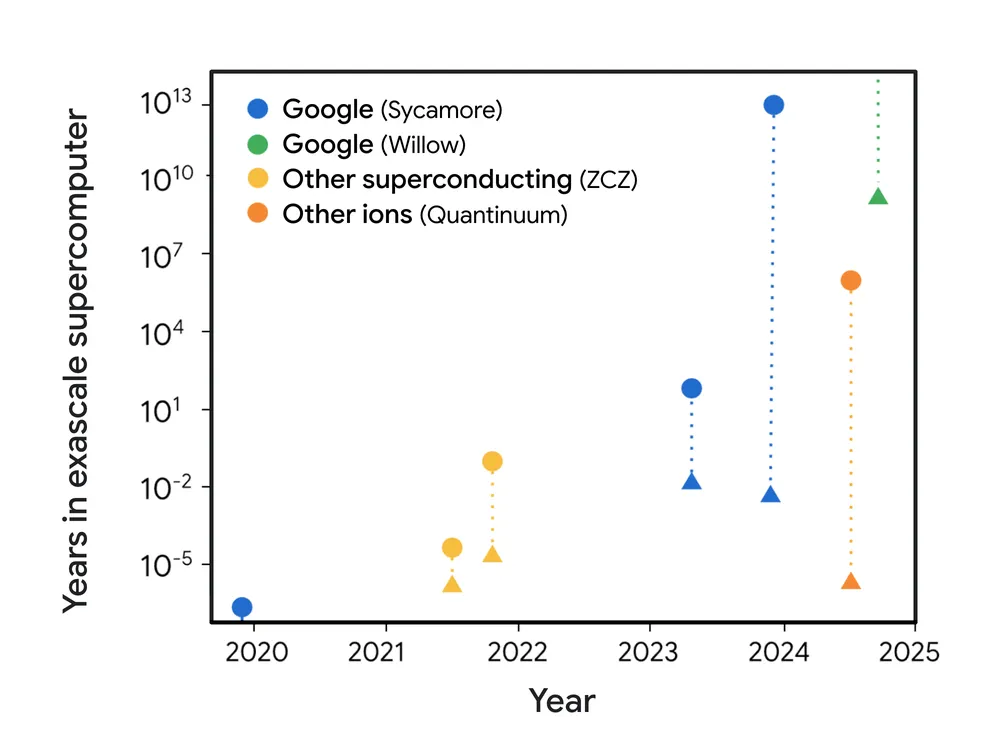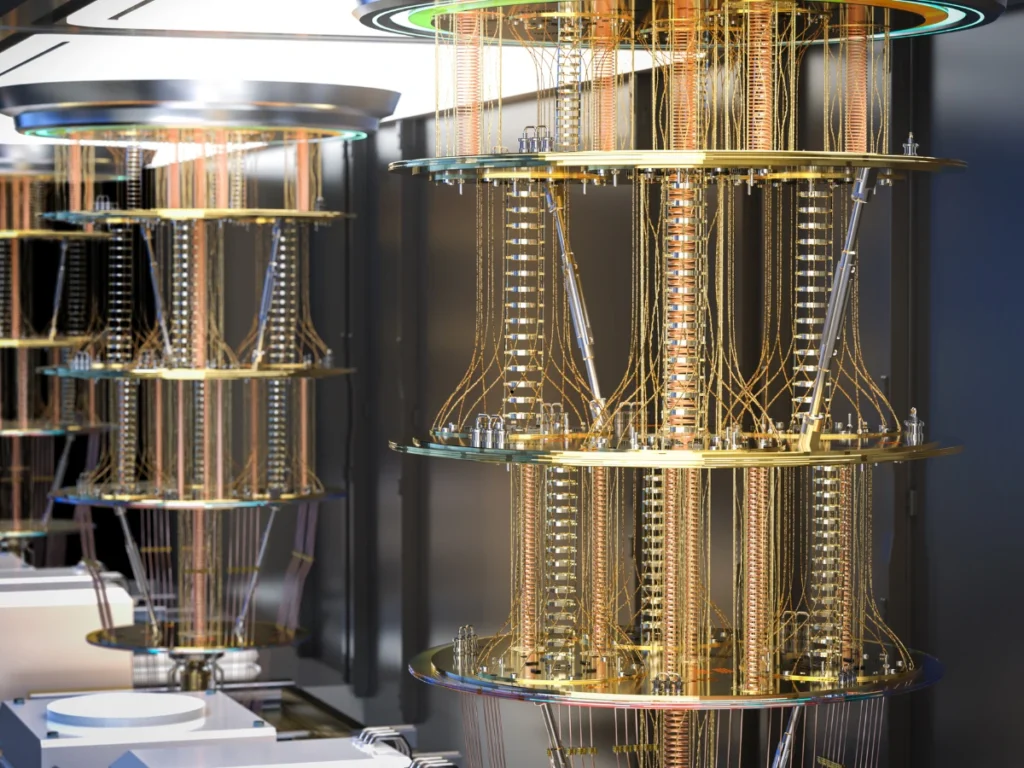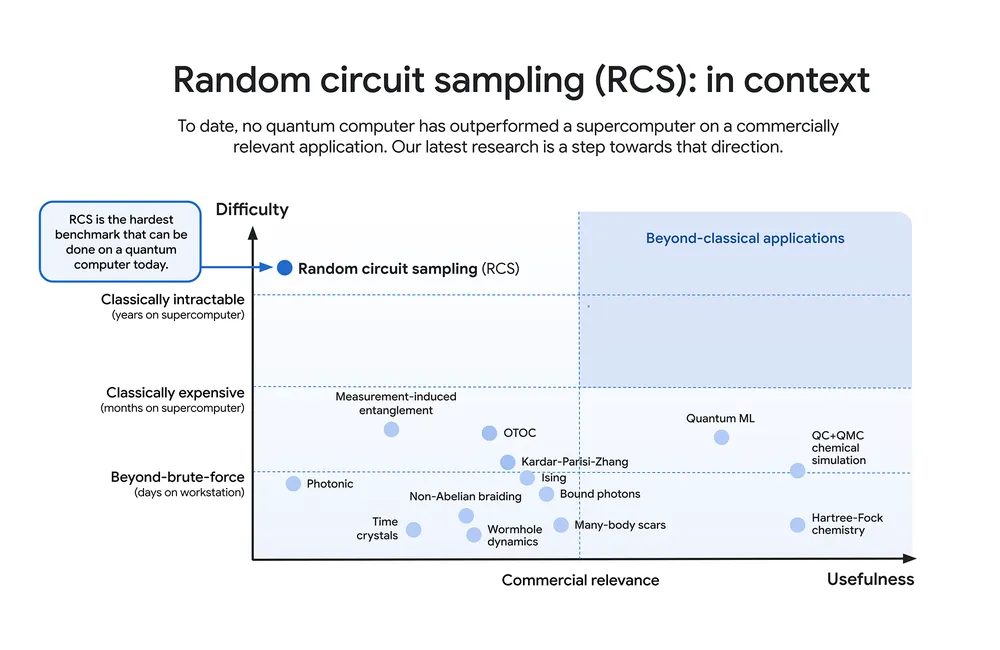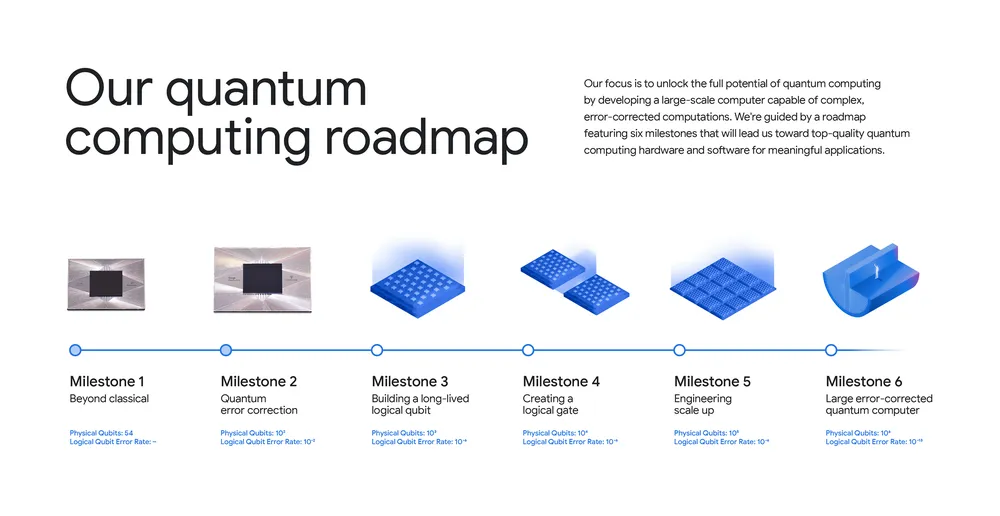“Google’s quantum chip Willow has emerged as a revolutionary force in the world of quantum computing. Equipped with an impressive 105 qubits, this new chip nearly doubles the capacity of its predecessor Sycamore. “

The Power of Google’s Willow
In a stunning demonstration of its capabilities, the chip solved a complex computational problem in under five minutes – a task that would require modern supercomputers approximately 10 septillion years to complete. This achievement marks a pivotal moment in computing history.

This staggeringly huge number exceeds known timeline in physics and greatly exceeds the age of the universe. This observation supports the many-worlds interpretation of quantum computing, aligning with Deutsch’s multiverse theory.
The implications of this breakthrough extend far beyond mere numbers. Experts at Google’s Quantum AI Lab suggest that,
“Through experience working with quantum systems, we have seen how Google’s quantum chip Willow leverages fundamental quantum mechanics principles, particularly superposition. The chip’s qubits can exist in multiple states simultaneously, a property that seems to defy classical physics.”
The remarkable computational speed demonstrated through Random Circuit Sampling has established new standards in benchmark problem solving, showcasing true quantum supremacy over traditional classical computers. This performance represents a quantum leap forward, quite literally, in our computational capabilities. You can also watch Willow’s Introduction here: Meet Willow! our state-of-the-art quantum chip
However, Willow achieves superior quality rather than just focusing on qubit quantity, since low-quality qubits offer little value regardless of their numbers. The chip’s 105 qubits have set new performance standards in quantum error correction and random circuit sampling benchmarks, which best measure overall system capabilities.
Specific performance metrics also show remarkable progress – notably, the T1 times (which measure how long qubits can maintain excitation) now reach nearly 100 microseconds, representing a fivefold improvement over previous chip generations. Check out this video where the Principal Scientist Sergio Boixo, Founder and Lead Hartmut Neven, and renowned physicist John Preskill discussing Random Circuit Sampling:
Accelerating Complex Problem-Solving
Google’s quantum chip Willow is revolutionizing how we address complex challenges across industries. Its computational power enables breakthroughs in fields that require intricate calculations and simulations. Following are the fields on which Google’s Quantum Chip Willow can make a significant impact:
Pharmaceuticals: pharmaceuticals rely on high-precision modeling to simulate molecular interactions and identify viable compounds for drug discovery. With Willow, these simulations can be completed in a fraction of the time, significantly reducing costs and accelerating the introduction of new medications to the market.
Material Science: The field of materials science benefits from Willow’s ability to analyze and optimize structures at the atomic level. Researchers can now develop stronger, lighter, and more efficient materials for use in industries such as aerospace, construction, and manufacturing. This capability supports innovations that were previously considered unattainable due to computational limitations.
Logistics: In logistics, quantum algorithms powered by Willow can optimize complex supply chain networks. These optimizations improve efficiency, reduce costs, and enhance overall performance. For instance, a logistics company can utilize Willow to model real-time data and optimize delivery routes, reducing fuel consumption and improving delivery times.
Renewable Energy: The renewable energy sector also stands to gain significantly. With Willow, engineers can optimize energy grid distributions and design advanced battery materials, contributing to a more sustainable future. The chip’s ability to solve intractable problems gives companies a distinct competitive advantage, fostering innovation and driving global progress in clean energy technologies.
By addressing problems previously deemed unsolvable, Willow demonstrates the transformative potential of quantum computing in shaping the future of industries. Its unparalleled ability to process complex calculations unlocks opportunities for growth and discovery, enabling us to tackle some of the world’s most pressing challenges.
Advancements in Machine Learning and AI

“The seamless integration of quantum computing with sophisticated AI models has opened new frontiers in processing enormous datasets. This breakthrough enhances model training efficiency and dramatically improves predictive capabilities.”
As someone who has worked extensively with AI systems, I have seen how these advancements are revolutionizing recommendation systems, natural language processing, and image recognition.
The implications for personalized healthcare are particularly striking. The chip processes vast amounts of patient data at unprecedented speeds, generating crucial real-time insights that inform treatment recommendations. Having previously struggled with the limitations of classical computing in analyzing complex medical data, I can confidently say this represents a paradigm shift in healthcare technology. The ability to process and analyze genetic sequences, medical imaging, and patient histories simultaneously could transform how we approach personalized medicine.
Implications for Cybersecurity Startups
The emergence of Google’s quantum chip Willow creates both significant challenges and opportunities in cybersecurity. Early-stage startups are grappling with an urgent problem: current encryption standards could become obsolete. This reality drives intense research into quantum-resistant security protocols to safeguard IT systems and online systems. Through my experience in cybersecurity consulting, I have observed how this quantum advancement is catalyzing a complete rethinking of digital security frameworks.
For pioneers in this burgeoning field, developing robust security measures has become critical. These cybersecurity solutions must anticipate and counter quantum-based threats before they materialize. The next generation of security protocols will establish new standards for digital protection, creating opportunities for innovative leaders to emerge. Companies that successfully develop quantum-resistant encryption could become the cornerstone of future digital infrastructure.
Access and Collaboration Opportunities
Google’s quantum chip Willow is democratizing quantum computing through innovative cloud-based platforms and strategic partnerships. This accessibility enables startups to tackle quantum processors without requiring massive capital investment in physical hardware. The technology democratization allows organizations to experiment, develop, and deploy groundbreaking quantum-based solutions more efficiently than ever before.
The formation of collaborative ecosystems involving startups, academic institutions, and established tech companies marks a new era in quantum computing development. These collaborations accelerate the creation of practical quantum computing solutions through shared knowledge and collective innovation.
Multiverse Debate and Its Implications

One of the most intriguing discussions surrounding Google’s quantum chip Willow is its role in the multiverse debate. The chip’s astonishing speed and computational power resonate with theories like David Deutsch’s multiverse interpretation. This theory posits that quantum computers leverage parallel universes to achieve computational feats.
David Deutsch’s work, rooted in the many-worlds interpretation of quantum mechanics, suggests that
“Every quantum computation involves branching into multiple, coexisting realities. In this framework.”
Google’s quantum chip Willow could be performing calculations across these parallel dimensions, lending credibility to the multiverse hypothesis. This interpretation highlights quantum computing’s potential to reveal hidden aspects of the universe.
Critics, however, argue that these achievements do not definitively prove the existence of a multiverse. Alternative explanations grounded in single-universe interpretations suggest the chip’s success stems from its advanced engineering rather than parallel realities. The Copenhagen interpretation, for example, describes quantum phenomena as probabilistic events within a single universe. Similarly, the pilot-wave theory offers deterministic explanations without invoking other dimensions.
Despite differing perspectives, the multiverse debate underscores the profound philosophical and scientific implications of quantum computing. The idea that Google’s quantum chip Willow might bridge theoretical physics with practical computation invites both excitement and skepticism. Whether or not the multiverse exists, Willow’s performance forces us to reconsider the boundaries of quantum mechanics and computation.
The multiverse discussion also opens doors for interdisciplinary research. Physicists, computer scientists, and philosophers are now collaborating to explore the deeper meanings of quantum phenomena. This blending of disciplines is a testament to the transformative impact of quantum computing, where each breakthrough generates new questions about the nature of reality itself.
Real-World Applications and Roads Ahead

Beyond theoretical debates, Google’s quantum chip Willow holds immense practical promise. Its capability to reduce errors exponentially while scaling up qubits addresses a long-standing challenge in quantum systems. This progress brings us closer to running commercially relevant algorithms that surpass classical computing in meaningful ways.
The field’s next milestone is to achieve a quantum computation that’s both beyond classical capabilities and practical for real-world applications, which they hope to accomplish with Willow chips. Current progress falls into two categories: the Random Circuit Sampling(RCS) benchmark (shows quantum advantage but lacks practical use) and Quantum Error Correction (scientifically valuable but within classical computing limits). They aim to bridge this gap by developing algorithms that both exceed classical computing power and solve commercially relevant problems.

Moreover, Willow’s applications in artificial intelligence extend beyond model training. By solving computationally intensive problems, it enables the development of sophisticated AI models capable of performing tasks that were previously out of reach. This includes advanced natural language processing, real-time image recognition, and more intuitive recommendation systems.
Looking ahead, Google’s quantum chip Willow represents the starting point for more advanced quantum systems. The roadmap includes achieving practical, real-world solutions that address critical global challenges. As researchers and engineers refine quantum algorithms, the potential for breakthroughs across industries becomes even more apparent.
Hence, Google invites researchers, engineers, and developers to join their Quantum Computing Community by analyzing their open source software and educational material. Where developers can learn the core principals of quantum error correction which will be helpful in generating algorithms that can solve complex future problems.

The Environmental and Social Impact of Google’s Quantum Chip Willow
Environmental Dimensions
The development of Google’s quantum chip Willow marks a significant milestone in computing, yet its environmental impact warrants careful consideration. The operation of these quantum systems requires extensive cooling infrastructure to maintain temperatures near absolute zero, essential for quantum coherence. These cooling systems consume substantial energy, prompting research into more efficient cooling technologies for Google’s quantum chip Willow and future iterations.
Resource utilization in the manufacturing of Google’s quantum chip Willow presents another environmental challenge. The production process requires rare materials and sophisticated fabrication techniques that must be managed sustainably. Environmental scientists and engineers are exploring innovative recycling methods and investigating alternative materials that could reduce the ecological footprint of quantum hardware manufacturing.
Social Responsibility and Ethics
The deployment of Google’s quantum chip Willow raises important questions about technological equity. As quantum computing capabilities advance, ensuring fair access to these resources becomes crucial. Strategic initiatives are being developed to prevent the concentration of quantum computing power within select organizations and to support broader access across research institutions globally.
Security considerations have emerged as a primary focus in the quantum era. The computational power of Google’s quantum chip Willow necessitates new approaches to data protection and encryption. International collaboration has been initiated to develop quantum-resistant security protocols, ensuring sensitive information remains protected as quantum capabilities expand.
Workforce Evolution
The introduction of advanced quantum technologies like Google’s quantum chip Willow is reshaping employment landscapes. Traditional computing roles are evolving, creating new opportunities while potentially displacing others. Comprehensive workforce development programs have been established to prepare professionals for the quantum computing era, including specialized training in quantum algorithms and hardware maintenance.
Educational Initiatives and Public Engagement
Understanding quantum computing principles has become essential for future technological advancement. Educational programs focused on Google’s quantum chip Willow and similar technologies are being developed at various academic levels. These initiatives range from introductory courses for the general public to advanced training for specialized professionals. Hence, Google has also introduced a course about Quantum Error Correction on Coursera. Click the link to check out: Hands-on quantum error correction with Google Quantum AI
Future Sustainability Framework
The future of quantum computing depends on developing sustainable operational practices. Research teams working with Google’s quantum chip Willow are focusing on reducing energy consumption while maximizing computational efficiency. This includes exploring renewable energy integration and investigating novel cooling technologies that could significantly decrease the environmental impact of quantum computing facilities.
Through these comprehensive approaches, the quantum computing community strives to ensure that technological advancement proceeds responsibly, with careful consideration for both environmental and societal impacts. Success in these areas requires continued collaboration between research institutions, industry leaders, and policy makers to create a sustainable quantum computing future.
A Personal Perspective
As a technology enthusiast, I find Google’s quantum chip Willow inspiring. Its computational efficacy redefines what is possible in information processing. For me, this technology represents a shift not only in computation but also in how we collaborate and innovate across disciplines.
The discussions surrounding Willow whether about multiverse interpretations or practical breakthroughs, illustrate the dynamic nature of quantum research. By bridging theoretical insights with tangible applications, Willow exemplifies the potential of quantum innovation to transform industries and expand human understanding.
Frequently Asked Questions
| What is Google Willow chip? | Google’s Willow chip is a significant advancement in quantum computing technology. It incorporates breakthroughs in quantum error correction. |
| What problem did Google Willow solve? | Willow demonstrated its capabilities by solving a complex computational problem through Random Circuit Sampling in under five minutes. |
| Where is Google’s quantum computer? | Willow was assembled in the new, astounding fabrication facility in Santa Barbara one of only a few facilities in the world built from the ground up for this purpose. |
| What is the significance of Google’s quantum computing chip “Willow”? | Willow, with 105 qubits, significantly outperforms its predecessor Sycamore, demonstrating the potential to revolutionize fields like pharmaceuticals, materials science, and AI. |
| How does Willow impact startups? | Willow accelerates complex problem-solving, advances AI, and poses both challenges and opportunities in cybersecurity for startups. |
| How can startups access and utilize quantum computing resources? | Cloud-based platforms and collaborations with Google and academia can provide startups with access to quantum processors and foster innovation. |
Conclusion
Google’s quantum chip Willow is not just a milestone in technology; it is a harbinger of a new era in computation. By demonstrating unparalleled computational power, Willow has proven its potential to transform industries ranging from healthcare to renewable energy, while also opening new frontiers in artificial intelligence and cryptography. Its ability to address previously intractable problems showcases the practical advantages quantum computing offers over classical systems.
The multiverse debate further elevates Willow’s significance, intertwining theoretical physics with technological progress. Whether or not Willow definitively proves the existence of parallel universes, its achievements compel us to rethink the nature of computation and reality. Such discussions spark innovation and collaboration, driving advancements in fields like quantum mechanics and interdisciplinary research.
Equally important are the collaborative opportunities Willow creates. By enabling access to quantum computing resources through cloud-based platforms and fostering partnerships between startups, academic institutions, and tech companies, Willow democratizes technology and accelerates innovation. This inclusivity ensures that the benefits of quantum breakthroughs are shared widely, driving global progress.
As a symbol of the boundless possibilities of quantum innovation, Google’s quantum chip Willow serves as both a practical tool and a source of inspiration. It reminds us that the future of technology is not confined to solving existing problems but also lies in expanding the limits of human imagination. With Willow, the journey toward a quantum-powered world has truly begun, promising a future brimming with discovery, progress and limitless potential.
You might want to read about AI and Healthcare Equity: Forging the Digital Divide, as well. This health digital divide mirrors that of those who have access versus those who do not have these digital technologies.



Leave a Reply